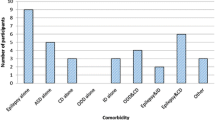Abstract
Purpose
The purpose of this prospective study is to investigate the relationship between Osgood–Schlatter disease (OSD) and attention deficit/hyperactivity disorder (ADHD).
Methods
Seventy-four children with a diagnosis of OSD were referred to child and adolescent psychiatry department for the evaluation of ADHD. Diagnostic and Statistical Manual of Mental Disorders was used for diagnostic criteria.
Results
Diagnosis of ADHD was made in 56 (75.6 %) out of 74 children.
Conclusions
Results of this study suggest that ADHD is a significant risk factor for OSD. During the evaluation of a patient with OSD, a thorough history should be obtained about the behavioral symptoms that indicate underlying ADHD. In case of suspicion, these patients should be referred for an additional evaluation by a child psychiatrist.
Level of evidence
II.

Similar content being viewed by others
References
Gholve PA, Scher DM, Khakharia S, Widmann RF, Green DW (2007) Osgood–Schlatter syndrome. Curr Opin Pediatr 19:44–50
de Lucena GL, dos Santos Gomes C, Guerra RO (2011) Prevalence and associated factors of Osgood–Schlatter syndrome in a population-based sample of Brazilian adolescents. Am J Sports Med 39(2):415–420. doi:10.1177/0363546510383835
Kujala UM, Kvist M, Heinonen O (1985) Osgood–Schlatter’s disease in adolescent athletes. Retrospective study of incidence and duration. Am J Sports Med 13:236–241
Demirag B, Ozturk C, Yazici Z, Sarisozen B (2004) The pathophysiology of Osgood–Schlatter disease: a magnetic resonance investigation. J Pediatr Orthop B 13(6):379–382
Gigante A, Bevilacqua C, Bonetti MG, Greco F (2003) Increased external tibialtorsion in Osgood–Schlatter disease. Acta Orthop Scand 74:431–436
Jacob RP, Von Gumppenberg S, Engelhard P (1981) Does Osgood–Schlatter disease influence the position of the patella? J Bone Jt Surg Br 63:579–582
Aparicio G, Abril JC, Calvo E, Alvarez L (1997) Radiologic study of patellar height in Osgood–Schlatter disease. J Pediatr Orthop 17:63–66
Lancourt JE, Cristini JA (1975) Patella alta and patella infera. J Bone Jt Surg Am 57:1112–1115
Sarcević Z (2008) Limited ankle dorsiflexion: a predisposing factor to Morbus Osgood–Schlatter? Knee Surg Sports Traumatol Arthrosc 16(8):726–728. doi:10.1007/s00167-008-0529-7
Pease CN (1934) Relationship of Streptococcus viridans to apophysitis of tibial tubercle. Am J Surg 24:149–150
Rosenberg ZS, Kawelblum M, Cheung YY, Beltran J, Lehman WB, Grant AD (1992) Osgood–Schlatter lesion: fracture or tendinitis? Scintigraphic, CT, and MR imaging features. Radiology 185(3):853–858
Sherry DD, Petty RE, Tredwell S, Schroeder ML (1985) Histocompatibility antigens in Osgood–Schlatter disease. J Pediatr Orthop 5(3):302–305
Frank-Briggs AI (2011) Attention deficit hyperactivity disorder (ADHD). J Pediatr Neurol 9(3):291–298. doi:10.3233/JPN-2011-0494
American Psychiatric Association (2000) The Diagnostic and Statistical Manual of Mental Disorders, fourth edition, text revision. American Psychiatric Association, Washington, DC
Uslu M, Uslu R, Eksioglu F, Ozen NE (2007) Children with fractures show higher levels of impulsive-hyperactive behavior. Clin Orthop Relat Res 460:192–195
Pastor PN, Reuben CA (2006) Identified attention-deficit/hyperactivity disorder and medically attended, nonfatal injuries: US school-age children, 1997–2002. Ambul Pediatr 6(1):38–44
Brook U, Boaz M (2006) Adolescents with attention deficit and hyperactivity disorder/learning disability and their proneness to accidents. Indian J Pediatr 73(4):299–303
Conflict of interest
The authors declare that they have no conflict of interest. No funds have been received for this study.
Author information
Authors and Affiliations
Corresponding author
Rights and permissions
About this article
Cite this article
Guler, F., Kose, O., Koparan, C. et al. Is there a relationship between attention deficit/hyperactivity disorder and Osgood–Schlatter disease?. Arch Orthop Trauma Surg 133, 1303–1307 (2013). https://doi.org/10.1007/s00402-013-1789-3
Received:
Published:
Issue Date:
DOI: https://doi.org/10.1007/s00402-013-1789-3



